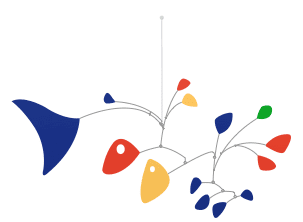Google published a doodle today that commemorates artist Alexander Calder with an interactive sculpture that sways when a person tilts an accelerometer-equipped laptop.
Calder is famous for sculptures he called mobiles--hanging weights and struts that are carefully counterbalanced so they slowly drift into new configurations. The Google doodle, published on Calder's 113th birthday, tilts when a laptop tilts and slowly spins if a person clicks and drags on the sculpture.
The swaying feature requires not just an accelerometer-equipped laptop but also a browser that can expose that information to a Web application. In my tests on a Mac this morning, that meant Chrome but not Safari or Firefox.
Google's doodles began as whimsical drawings that provided a bit of variation on the company's primary-color logo. They've steadily increased in prominence and sophistication, though, with an annual contest for students to draw their own and ever more dynamic doodles.
Examples include a playable Pac-Man game, a musical tribute to guitarist Les Paul, and leaping dancers.
The company now has a dedicated team of Google doodle artists. They get to recognize famous moments and people--and to help Google with its mission of evangelizing the world of Web programming and the abilities of its own browser.
Marissa Mayer, a Google executive with a penchant for art, touted the doodle on Twitter and on Google+.
"The amazing Alexander Calder logo is up! It's a simulation of an actual working mobile--also, note the shadow below the search box and buttons," Mayer said. "Click and drag to put the mobile in motion. Also, if you pick up your laptop and rock it from side to side, the mobile swings and moves (cool use of the accelerometer in most laptops)."
Calder is famous for sculptures he called mobiles--hanging weights and struts that are carefully counterbalanced so they slowly drift into new configurations. The Google doodle, published on Calder's 113th birthday, tilts when a laptop tilts and slowly spins if a person clicks and drags on the sculpture.
The swaying feature requires not just an accelerometer-equipped laptop but also a browser that can expose that information to a Web application. In my tests on a Mac this morning, that meant Chrome but not Safari or Firefox.
Google's doodles began as whimsical drawings that provided a bit of variation on the company's primary-color logo. They've steadily increased in prominence and sophistication, though, with an annual contest for students to draw their own and ever more dynamic doodles.
Examples include a playable Pac-Man game, a musical tribute to guitarist Les Paul, and leaping dancers.
The company now has a dedicated team of Google doodle artists. They get to recognize famous moments and people--and to help Google with its mission of evangelizing the world of Web programming and the abilities of its own browser.
Marissa Mayer, a Google executive with a penchant for art, touted the doodle on Twitter and on Google+.
"The amazing Alexander Calder logo is up! It's a simulation of an actual working mobile--also, note the shadow below the search box and buttons," Mayer said. "Click and drag to put the mobile in motion. Also, if you pick up your laptop and rock it from side to side, the mobile swings and moves (cool use of the accelerometer in most laptops)."

No comments:
Post a Comment